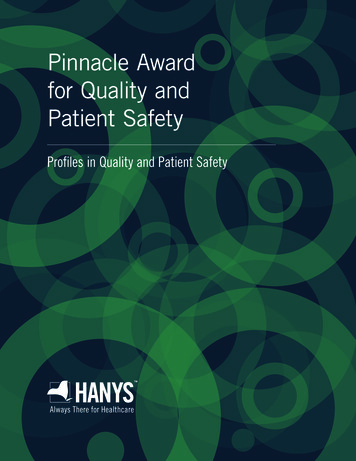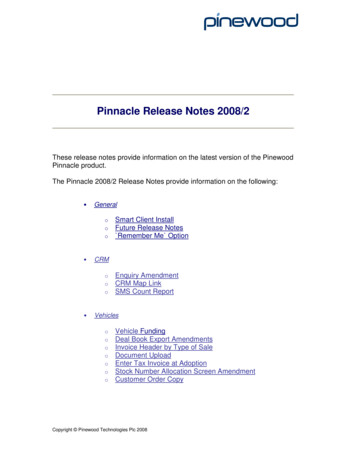
Transcription
Pinnacle Awardfor Quality andPatient SafetyProfiles in Quality and Patient Safety
D SOMTET HAVE TUSHINGS JETHANYSPRINTINGSERVICESQUALITY AFFORDABLE TIMELYContact us for all your printing needs.518.431.7920 www.hanysprintingservices.comE PRO B IN
We are pleased to share this annualcompendium of the nominations for HANYS’Pinnacle Award for Quality and Patient Safety,which recognizes organizations that are leadersin promoting improvements in healthcaredelivery in New York State.HANYS is pleased to highlight 114 nomineesfrom across the state that are taking bold stepsto improve patient care and outcomes. Duringthis time of rapid change and uncertainty, theirpassion for innovation and ongoing improvementis critical to advancing the health of individualsand communities.HANYS thanks its members for their willingnessto share their ideas, experiences and successesthrough their Pinnacle Award submissions. Weencourage all members to take advantage of theinformation in this publication as a means toinform and accelerate ongoing efforts to improvequality and patient safety.Sincerely,Bea Grause, RN, JDPresident
2018 WinnersPost-Acute/OutpatientProviderBassett Healthcare NetworkUsing Project ECHO to Spread Primary Care-based Buprenorphine Managementfor Opioid Addiction: Life-Saving System TransformationDr. James Anderson, Medical Director forBehavioral Health and Integrated Services,accepted the Pinnacle Award on behalf ofBassett Healthcare Network; pictured herewith Nick Henley, HANYS' Vice President ofExternal Affairs (left); and Dr. Robert Panzer,HANYS’ Quality Steering Committee Chairmanand Associate Vice President for PatientCare Quality and Safety and Chief QualityOfficer, Strong Memorial Hospital (right).Hospital withLess than200 BedsSt. Joseph HospitalThe Cultural, Clinical and Operational Benefits of Establishing a RobustSafe Patient Handling ProgramChristopher Cells, RN-BC, CPHQ, MSN,Director of Nursing Informatics andPerformance Improvement (second fromleft), and Robert Ehlers, Director of PhysicalTherapy (second from right), accepted thePinnacle Award on behalf of St. JosephHospital, Bethpage; pictured here withNick Henley, HANYS' Vice Presidentof External Relations (left); and Dr.Robert Panzer, HANYS’ Quality SteeringCommittee Chairman and AssociateVice President for Patient Care Qualityand Safety and Chief Quality Officer,Strong Memorial Hospital (right).
Hospital with200–500 BedsGood Samaritan Hospital Medical CenterReducing Hospital Contaminated Blood Culture Rate through OrganizationalTransparency and Surveillance of Individualized Collector RatesThomas Ockers, Executive Vice Presidentand Chief Administrative Officer (center),accepted the Pinnacle Award on behalfof Good Samaritan Hospital MedicalCenter; pictured here with Nick Henley,HANYS’ Vice President of External Affairs(left); and Dr. Robert Panzer, HANYS’Quality Steering Committee Chairmanand Associate Vice President for PatientCare Quality and Safety and Chief QualityOfficer, Strong Memorial Hospital (right).System or Hospitalwith 500 BedsNorthwell Health SystemThe Path of Least Resistance: An Organization-wide Approach to Antimicrobial StewardshipMark Solazzo, Executive Vice President andChief Operating Officer (center), acceptedthe Pinnacle Award on behalf of NorthwellHealth; pictured here with Nick Henley,HANYS' Vice President of External Affairs(left), and Dr. Robert Panzer, HANYS’Quality Steering Committee Chairmanand Associate Vice President for PatientCare Quality and Safety and Chief QualityOfficer, Strong Memorial Hospital (right).
Table of ContentsChapter 1: Clinical ImprovementsDestination Zero Harm: Reducing Overall Quality Composite Score by 50%through High Reliability TechniquesArnot Ogden Medical Center, Elmira .1Developing a Culture of Antibiotic Stewardship in Post-acute CareColer-Goldwater Specialty Hospital, NYC Health Hospitals .2Improving Care for Sepsis Patients: Teamwork and Process Redesignwith Enhanced New York State Sepsis Measure ComplianceBrookhaven Memorial Hospital Medical Center, Patchogue .3Orthopedic Nurse Navigator ProgramCanton-Potsdam Hospital.4Emergency Medicine System Approach to Combat Opioid EpidemicCatholic Health Services of Long Island, Rockville Centre.5Collaboration in Action: Cultivating Superior Blood Culture RatesCortland Regional Medical Center .6Improving Quality, Outcomes and Inter-professional CollaborationUsing a Surveillance Warning ToolThe University of Vermont Health Network–Champlain Valley Physicians Hospital, Plattsburgh .7Creation of a Mindful Culture Change in Geropsychiatric Fall ReductionErie County Medical Center, Buffalo .8Reducing Hospital Contaminated Blood Culture Rate through OrganizationalTransparency and Surveillance of Individualized Collector RatesGood Samaritan Hospital Medical Center, West Islip .9Saving Lives–A Collaborative, Data-driven Initiative to Reduce Sepsis MortalityAcross a Health SystemHealth Quest, LaGrangeville .10Safe Patient Handling: A Move with Care ProgramKenmore Mercy Hospital.11Clinical Decision Algorithm for Suspected Pulmonary EmbolismEnhances Patient Safety and OutcomesMather Hospital–Northwell Health, Port Jefferson .12Safeguarding Hospitalized Diabetic Patients: An Innovative Glycemic Control InitiativeMather Hospital–Northwell Health, Port Jefferson .13Sustaining Improved Pain Management Patient SatisfactionAmid the Expanding Escalation of the Opioid EpidemicMercy Hospital of Buffalo .14Initiative to Reduce Hypoglycemia EventsNathan Littauer Hospital and Nursing Home, Gloversville .15
An Evidence-based Individualized Fall Prevention ProgramNorthern Westchester Hospital, Mount Kisco .16The Path of Least Resistance: An Organization-wide Approach to Antimicrobial StewardshipNorthwell Health, Great Neck .17Vancomycin Utilization Optimization ProjectNYC Health Hospitals / Bellevue .18Inpatient Hospice Initiative: Success in Improving Patient Care at End of LifeNYU Langone Health, New York City.19Improving Sepsis Care through Team-based AccountabilityNYU Langone Hospital–Brooklyn .20Improving Communication about MedicationsNYU Langone Orthopedic Hospital, New York City .21Utilizing ABCDEF Bundle in the ICUOlean General Hospital .22Enhancing Recovery, Outcomes and Experience of the Total Joint Replacement PatientOrange Regional Medical Center, Middletown .23The Journey of Decreasing Sepsis Mortality“Sometimes it’s how you get there that actually gets you there”Southside Hospital, Northwell Health, Bay Shore .24Improving Patient Peripheral AccessPhelps Hospital, Northwell Health, Sleepy Hollow .25The Impact of Restraint Reduction and Unplanned Extubations and Delirium in Critical CareSt. Catherine of Siena Medical Center, Catholic Health Services of Long Island, Smithtown .26“Striving for Zero”–Proactive Rounding to Eliminate Hospital-acquired InfectionsSt. Catherine of Siena Medical Center, Catholic Health Services of Long Island, Smithtown .27Reducing Sepsis and Septic Shock Mortality through Sepsis Bundle ComplianceStony Brook Medicine .28Sepsis Improvement JourneyThe Brooklyn Hospital Center.29Reducing Opiate Use with Robotic-assisted Hernia RepairThompson Health, University of Rochester Medicine, Canandaigua .30Improving Outcomes for Patients with Malnutrition: Enhanced Clinical Practicesto Promote Decreased Length of Stay and Reduced ReadmissionsThe University of Vermont Health Network–Champlain Valley Physicians Hospital, Plattsburgh .31Decreasing Postoperative Pneumonia through the Implementation of a ColorectalEnhanced Recovery After Surgery ProgramWhite Plains Hospital .32
Chapter 2: Enhancing Culture and Achieving High ReliabilityAnnual Peak of Excellence Award ProgramAdirondack Health, Saranac Lake .35Transformational Leadership Principles Focused on Employee Engagementand Service ImprovementBassett Healthcare Network–Aurelia Osborn Fox Memorial Hospital, Oneonta.36Engaging Nursing Leadership to Advance Evidence-based Practice, Strategic Goalsand Culture Change within Clinical NursingLong Island Jewish Valley Stream .37Daily Safety HuddleNYC Health Hospitals / North Central Bronx .38Leading a Culture Change: A Data-driven Approach to Improving Compassionate Carethrough a Palliative Medicine InitiativeNorthwell Health–Krasnoff Quality Management Institute, New Hyde Park.39Enhancing PACU to Acute Unit Patient Flow and Increasing Operational Efficiencyas a High Reliability OrganizationNYU Langone Orthopedic Hospital, New York City .40Chapter 3: Improvements Across the Care ContinuumAdapting the System’s Error Prevention and Safety Programto the Physician Practice EnvironmentCatholic Health Services of Long Island, Garden City .43Comprehensive Care for Joint Replacement Model in Home Care:Partnering for Better OutcomesCatholic Home Care, Catholic Health Services of Long Island, Farmingdale .44Person-centered Palliative Approach to Care in Long-term CareGood Samaritan Nursing Home, Catholic Health Services of Long Island, Sayville .45Community-based Palliative Care in Home HealthMJHS Home Care, Brooklyn.46Quitting Tobacco Products: A Plan to Provide Cessation Servicesin the Inpatient and Ambulatory Care SettingsNYU Langone Health, New York City.47Reducing Re-hospitalization Rates Across the Continuum of CareOur Lady of Consolation Nursing and Rehabilitative Care Center, West Islip .48Long-term Care Quality Enrichment ProgramRochester Regional Health .49Improving Pressure Ulcer Management and DocumentationSt. Catherine of Siena Nursing and Rehabilitation Care Center,Catholic Health Services of Long Island, Smithtown .50Regional Tick-borne Disease Resource CenterStony Brook Southampton Hospital .51
Bundled Payments for Care Improvement Initiative with Focus on PatientsDischarged into a Skilled Nursing Facility Performance NetworkUnited Health Services Hospitals, Inc., Johnson City .52Intensive Transitions TeamUpstate University Hospital, Syracuse .53Chapter 4: Improving Organizational EfficienciesImproving Patient Access to Gastrointestinal ProceduresBassett Healthcare Network, Cooperstown .57Quality and Safety Align Infection Control Practices to Improve Efficiency,Outcomes and ExperienceBassett Medical Center, Cooperstown .58Implementation of Actionable Dashboards: Improving Population Healthwith Integrated Dashboards and Team-based CareBronx-Lebanon Hospital Center .59Improving Patient-centered Care and Patient/Caregiver/Employee Satisfactionby Streamlining EMR DocumentationGood Shepherd Hospice, Catholic Health Services, Farmingdale .60Remote Home Monitoring ProgramColumbia Memorial Health, Hudson .61Reducing Delay in Diagnosis of Malignancy with Multi-stage RadiologyRecommendation TrackingF. F. Thompson Hospital, Canandaigua.62Can I Help You Get the Care You Want and Need? Lowering Over-utilizationJamaica Hospital Medical Center, Richmond Hill .63Utilizing Decision Support to Prevent Wrong Patient ErrorsNewYork-Presbyterian Hospital, New York City .64A Proactive, Interdisciplinary Approach to Secure Hospital CampusesNorth Shore University Hospital, Manhasset .65Transforming Emergency Department Care Delivery Using a Hospital-wideThroughput ProgramOrange Regional Medical Center, Middletown.66Reducing Waiting Times During Transitions of CarePhelps Hospital, Northwell Health, Sleepy Hollow .67Emergency Department “Front-end” Process Improvement InitiativeRichmond University Medical Center, Staten Island .68HIMSS Analytics Electronic Medical Record Adoption Model Stage 7Rochester Regional Health .69Standardization of CT Contrast Utilization in the Emergency DepartmentRome Memorial Hospital .70The Cultural, Clinical and Operational Benefits of Establishing a RobustSafe Patient Handling ProgramSt. Joseph Hospital, Bethpage .71
Reducing Preoperative CAT Scan Utilization in Appendectomy PatientsGolisano Children’s Hospital, Strong Memorial Hospital, Rochester.72Unit-based Physical Therapists Promote Early ICU Mobility and Contribute toHospital Net Operating MarginStrong Memorial Hospital, University of Rochester Medical Center .73Reduction of Medication ErrorsWyoming County Community Health System, Warsaw.74Chapter 5: Patient Experience of CareIncreasing Patient Satisfaction for “Quiet Around Room at Night” Scoreswith the White Noise Machines on a Medical/Surgical UnitMercy Hospital of Buffalo .77Safe Sleep: A Continuous Quality Improvement Initiative Ensuring Sleep, Patient Safetyand Patient SatisfactionNYU Langone Health, New York City.78Improving the Patient Experience by Creating a Culture of Service and Clinical ExcellenceSouth Nassau Communities Hospital, Oceanside .79Chapter 6: Providing Care to Special PopulationsUsing Project ECHO to Spread Primary Care-based Buprenorphine Managementfor Opioid Addiction: Life-saving System TransformationBassett Healthcare Network, Cooperstown .83Telepsychiatry: Improving Care for the Behavioral Health Patient in CrisisCatholic Health Services of Long Island, Rockville Centre.84The Effects of Positive Supports on Aggression in People with Intellectual DisabilitiesMaryhaven Center of Hope, Catholic Health Services of Long Island, Port Jefferson .85Let’s BEE Mindful : Caring for Children with Special NeedsCohen Children’s Medical Center, Northwell Health, Queens .86Providing Support and Education to Frontline Staff Treating Patientswith Substance Use IssuesEllis Medicine, Schenectady .87Post-discharge Phone Calls Positively Impact the Burn Intensive CarePatient Experience and Support for Burn PatientsErie County Medical Center Corporation, Buffalo .88Behavioral Health Management in a Community Hospital–Improving Patient and Caregiver Safety and EngagementHighland Hospital of Rochester.89The Center for Transgender Medicine and SurgeryMount Sinai Beth Israel, New York City .90Decrease of Primary Cesarean SectionsMount St. Mary’s Hospital and Health Center, Lewiston .91Use of a Sensory Modulation Room in an Inpatient Adolescent UnitNYC Health Hospitals / Metropolitan .92
Behavioral Emergency Response Team: Improving Safety in the Preventionand Management of Disruptive Behaviors in Non-psychiatric Inpatient SettingsNYU Langone Health, New York City.93Cesarean Surgical Site Infection Prevention Process Improvement ProjectNYU Langone Health, New York City.94Chapter 7: Reducing Hospital-acquired Conditions and ReadmissionsHemodialysis Catheter Reduction Quality ProjectAlbany Medical Center, Dialysis Clinic, Inc. .97Reduction of Hospital-acquired Clostridium Difficile in an Academic Medical CenterAlbany Medical Center .98Infection Control and Prevention in the Operating RoomAurelia Osborn Fox Memorial Hospital, Oneonta .99Journey to Zero HAPI, Leaders Enhancing Sustainable Outcomesin the Prevention of Hospital-acquired Pressure InjuryBrookdale University Hospital Medical Center, Brooklyn .100Reduce the Rate and Spread of Clostridium Difficile through a Multidisciplinary ApproachCayuga Medical Center at Ithaca.101The Use of COPD Education Folders to Reduce 30-day ReadmissionsEllis Medicine, Schenectady .102Reducing Healthcare-acquired Clostridium Difficile Rates by ReducingUnnecessary Testing and TreatmentGeneva General Hospital .103Reduction of Catheter-associated Urinary Tract Infections Related to InsertionGood Samaritan Hospital Medical Center, West Islip .104Taking the Pressure Out of Wound Care–A Hospital-wide Approach to Reducethe Number of Hospital-acquired Pressure InjuriesLong Island Jewish Valley Stream .105Preventing Hospital-acquired Clostridium Difficile Infections: It Takes a TeamLong Island Jewish Forest Hills, Northwell Health .106Striking Out Clostridium DifficileMercy Medical Center, Rockville Centre .107Reduction of Blood Culture Contamination in the Emergency DepartmentMercy Medical Center, Rockville Centre .108Central Line-associated Blood Stream Infection Reduction PlanMohawk Valley Health System–St. Luke’s Campus, Utica .109Decrease Outcome Disparities and Improving Resource Use in an Underinsuredand Uninsured Population Undergoing Hip and Knee ReplacementNYC Health Hospitals / Elmhurst .110Developing and Implementing Tools for the Reduction of Catheter-associatedUrinary Tract InfectionsMohawk Valley Health System, Utica .111
Using a Bundled Approach to Reduce Colon Surgical Site Infection:Implementation of the Advanced Colon Surgery BundleNYC Health Hospitals / Metropolitan .112A Multidisciplinary Approach to Reducing Hospital Onset Clostridium Difficile InfectionNYU Winthrop Hospital, Mineola.113C. Differently–A Proactive Approach to Tackling Clostridium DifficileOlean General Hospital .114STOP Central Line Bloodstream InfectionsOneida Healthcare .115The Patient Engagement Factor: Successful Strategiesfor Heart Failure Readmission ReductionSaratoga Hospital .116C the Difference One Hospital Can Make in Reducing Healthcare-associated InfectionsSt. Charles Hospital, Port Jefferson .117Catheter-associated Urinary Tract Infection Reduction InitiativeSt. Elizabeth Medical Center, Mohawk Valley Health System, Utica .118Reducing Clostridium Difficile with the Department of Environmental ServicesSt. Francis Hospital–The Heart Center, Roslyn .119Impact of Implementing an Antimicrobial Stewardship Program on Bacterial Resistance,Clostridium Difficile Incidence and Antibiotic ExpendituresSt. Joseph Hospital, Bethpage .120Implementing a Comprehensive Strategy Decreased Central Line Utilizationand Central Line-associated Bloodstream InfectionSt. Joseph’s Hospital Health Center, Syracuse .121STEP-PUP to SafetySt. Luke’s Cornwall Hospital, Newburgh .122Reduction of All-cause Readmissions of Patients witha Diagnosis of Congestive Heart FailureSt. Mary’s Healthcare, Amsterdam .123Maximal Reduction of Catheter-related InfectionsSt. Barnabas Health System, Bronx .124The Road to Reducing Catheter-associated Urinary Tract InfectionsStony Brook University Hospital .125Prevention of Hospital-acquired Pressure Injuries in a 268-bed Acute Care FacilityUnity Hospital, Rochester Regional Health .126A Mindful Approach to Preventing Catheter-associated Urinary Tract InfectionsWhite Plains Hospital .127
These resources and tools are provided by healthcarefacilities as a reference and can be adapted for use by yourfacility, if desired. These resources are provided “as is,”with no warranties whatsoever. You expressly understandand agree that HANYS disclaims any and all responsibilityor liability for the accuracy, content, completeness, legalityor reliability of information or material contained herein. Youunderstand and agree that information obtained through thispublication is done at your own discretion and risk.For full terms of use, please visit HANYS Terms of Use.
Chapter 1ClinicalImprovements
Destination Zero Harm: Reducing Overall Quality Composite Scoreby 50% through High Reliability TechniquesArnot Ogden Medical Center, ElmiraContactAnu Banerjee, MS, MHMChief Quality and InnovationOfficer(607) 735-5742abanerjee@arnothealth.orgThe focus of Arnot Ogden Medical Center’shigh-reliability journey was on improvingits quality composite score, which iscomprised of five measures: centralline-associated blood stream infections(CLABSIs), catheter-associated urinarytract infections (CAUTIs), falls with injuries(moderate and major), hospital-acquiredpressure injuries (HAPIs), Clostridiumdifficile and hand hygiene.Arnot Ogden Medical Center beganby initiating several committees,implementing best practice bundles andincluding key members to drive change.The committees included engagedphysician champions, frontline staff andstakeholders with the ability to achievechange. The role of these groups was toresearch best practice and evidence-basedbundles. Baseline data were collectedand compared with national benchmarks.Collaboratively, new work flows and bestpractice initiatives were implemented toimprove patient outcomes and improvesafety.Outcomes Achieved Best practice bundles can bechallenging to implement across thecontinuum of care. Improved communication anddocumentation is key in processimprovement. Breaking down silos and hardwiringstandard processes across all clinicalareas is
Richmond University Medical Center, Staten Island .68 HIMSS Analytics Electronic Medical Record Adoption Model Stage 7 . Post-discharge Phone Calls Positively Impact the Burn Intensive Care Patient Experience and Support for Burn Patients











